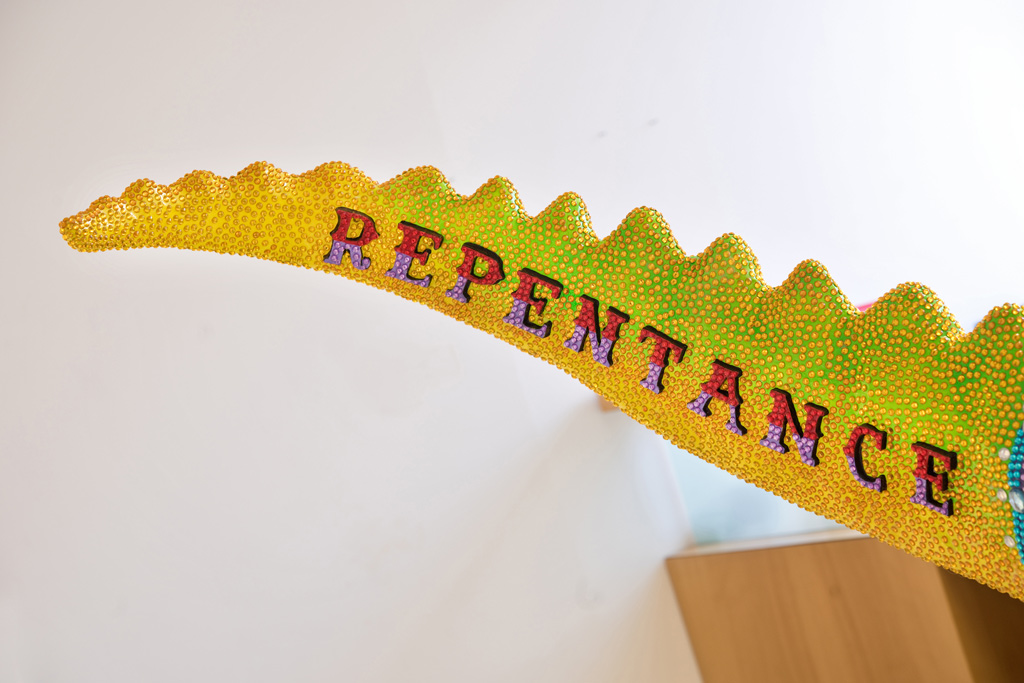The Vagaries and Misconceptions of the Modern Man
Ralph Darbyshire, Richard Hollinshead, Kenneth Ross
19 January – 24 February 2018
Ralph Darbyshire, Not Really Understanding Stuff: A Reptile Reliquary, 2017, mixed media, 180x300x900cm. Photo: Colin Davison
‘The Vagaries and Misconceptions of the Modern Man’ brings together recent sculptural works by Ralph Darbyshire, Richard Hollinshead and Kenneth Ross in an exhibition that explores the fallibilities in seemingly certain masculine positions.
Figurative in the broadest sense, these sculptural works collectively engage with difficult material, whether brashly explicit or operating as a disquieting undercurrent; and whether concerned with political unrest, sexuality, violence or male body image.
Ralph Darbyshire manipulates objects and imagery to create works that offer the viewer a sustained encounter that is at once seductive and confusing. Ostentatious and theatrical, it is biography that is most apparent in these works, with a myriad of ephemera vying for attention. In Not Really Understanding Stuff: A Reptile Reliquary (2017) a monstrous crocodile fills the room. Covered in plastic gems, fake fur, poetry, and draped in garlands and rosettes with the face of an inflatable doll peering from between its jaws, this beast is at once awe-inspiring and humorous. Along its flanks are frames containing images from the internet: ranging from saints to pin-ups to mutilation and murder victims. Darbyshire marries a sense of helplessness at world events with a celebration of the joy of making, of creation. In Not Knowing (2011) a horse, covered in Post-it-notes, appears to have machine guns penetrating its body. A ceramic head sits on its haunches with another horse-head emerging from its mouth. On top of the head a golden disc is emblazoned on both sides with portraits of the artist. The horse’s head emerging from the ceramic head relates to the Roman philosopher Pliny’s first century book of natural history in which he claims that the weasel conceives through the ear and gives birth through the mouth. The weasel signifies people who willingly hear ‘the seed of the divine word’, but then do nothing with what they have heard. Darbyshire reflects his own internal chaos and inability to process these visual inputs, with his sculptures aiming to sanction and legitimise the act of ‘not knowing’, with information stacked to the point of overload.
Richard Hollinshead references the visual language of classical Greek sculpture, and the idealised male form it promotes, to explore contemporary male identity. Sanit Forma (2018) references the louche form of the Barberini Faun, a 3rd century BC Hellenistic sculpture copied numerous times throughout the 17th to 19th centuries. Influential on generations of sculptors from Bernini (who worked on its restoration) onwards, the Barberini Faun is part of an established lineage in the study of sculpture and has a wider influence on defining an idealised male body. Sanit Forma reworks this composition in relation to gym culture and contemporary male identity, with the ‘faun’ engaged with a gym-type structure that simultaneously offers support, constraint and inspection. A towel hangs down from the support structure, forming a ‘cape’ for the figure, but this putative superhero will never fly. Dependable Bodies (2016) is one of a series of three etchings set within an Arcadian landscape. A skeletal creature – with clear signs of mutation and imperfection – examines the idealised form of male legs and genitals. Hollow, these legs suggest an invitation to be inhabited, to be animated; but simultaneously point to a façade or superficiality. Behind this interaction a putto or cherub hovers, waiting to offer some form of dressing and anointment.
Kenneth Ross’ work explores the proliferation of the ‘Banal’ in both image and language in contemporary society. It is the banality of hatred – of misogyny or racism, faith and the treatment of death, or the fetishisation of sex. Ross looks at the glorification of banality, how it is disseminated and perpetuated, exploiting our basest desires and blinding us to the inherent violence within. Bristol Temples (2017) and Altar of the Wood Sprite (2018) are votive altars that tap into ancient beliefs and superstitions and the collective fear of the unknown. In The Hands of God (2017) a human sized cartoon-like figure, tattooed with arcane symbols, stands as if in the final throws of auto-erotic asphyxiation, a noose around its neck. Together with Fucked Either Way (2017) and Bukkake Angel (2017) these works stand as metaphors for the intrinsic association between sex and violence in the debased images of pornography that have spread into popular culture. Mouthpiece 17151 (2017) shows images of the artist taken when he was 17,151 days old. Ross is shown screaming into the void – a visceral cry of anger at the world.
‘The Vagaries and Misconceptions of the Modern Man’, 2018, installation view. Photo: Colin Davison
‘The Vagaries and Misconceptions of the Modern Man’, 2018, installation view. Photo: Colin Davison
Ralph Darbyshire was born in 1966 in Birkenhead and lives in Southport, UK. He holds a BA Fine Art from Exeter College of Art & Design, MA Sculpture Studies from University of Leeds and a PhD from the University of Plymouth. He has exhibited widely, including the Liverpool Biennial, China, France, Singapore, Sweden, UK and USA.
Richard Hollinshead was born in 1973 in Newmarket and lives in Northamptonshire, UK. He holds a BA Fine Art from Southampton, MA Sculpture from Winchester School of Art and a PhD from the University of Lincoln. He has exhibited in galleries in the UK, Germany and Australia, and created site-specific projects for Yorkshire Sculpture Park and various permanent locations in the UK.
Kenneth Ross was born in 1971 in Inverness and lives in Northamptonshire, UK. He holds a BA Design (Ceramics) from Glasgow School of Art and MFA Fine Art from the University of Newcastle. He has exhibited in the UK.
The exhibition is supported by the University of Northampton and Arts Council England.
Take a video tour of the exhibition
Share this page











